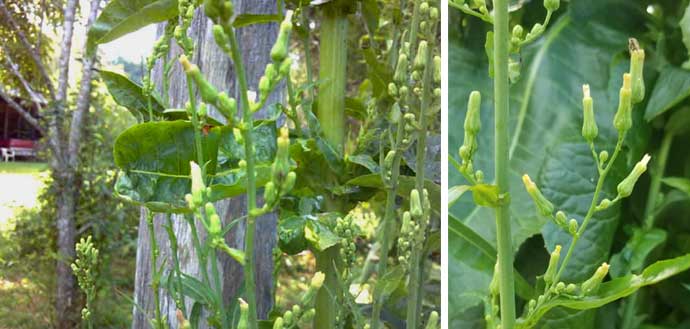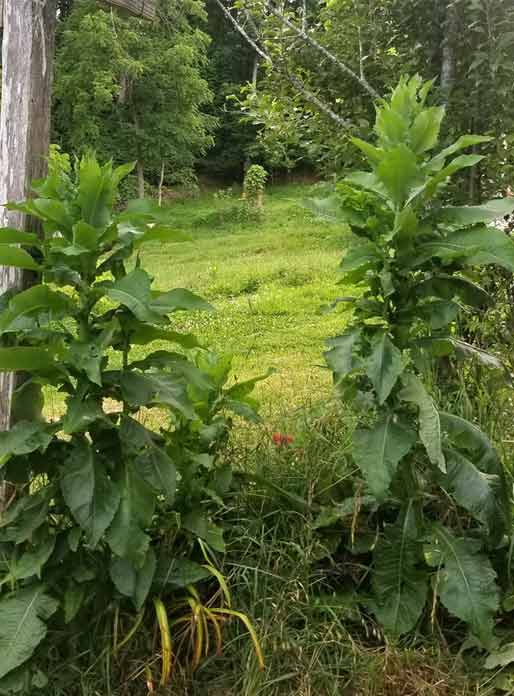Wild lettuce as a natural herbal medicine
Wild lettuce (Lactuca virosa) has a milky, bitter tasting sap that contains the compounds lactucin, lactucopicrin, and lactucarium. These compounds have sedative and analgesic effects which can help treat anxiety, panic attacks, insomnia, and pain.
Wild lettuce is also used to treat some lung conditions and cough. It also has anti-inflammatory properties, which makes it useful when treating arthritis and other inflammatory conditions.

Wild lettuce and pain relief
Wild lettuce is good for muscle pain, headache, and menstrual cramps. Wild lettuce has analgesic effects that fight pain and inflammation.
The pain-relieving effects of wild lettuce are thought to be due to its content of sesquiterpene lactones, a group of compounds that have sedative and analgesic properties.
Please note that wild lettuce does not get people “high” like morphine and opium. Never take large amounts of wild lettuce. Too much can be poisonous! Wild lettuce can be toxic, especially when fresh.
Wild lettuce and insomnia
Wild lettuce can help to promote sleep. It is thought to work by increasing the production of the neurotransmitter GABA, which has a calming effect on the brain.
Wild lettuce helps to treat insomnia naturally by calming the central nervous system. It can also be used to treat restless leg syndrome.
Wild lettuce and anxiety
Wild lettuce can help to reduce anxiety and panic attacks. It is thought to work by blocking the action of the neurotransmitter glutamate, which is involved in the transmission of anxiety signals in the brain.
Wild lettuce promotes relaxation that can help calm generalized anxiety disorders and panic disorders.
Wild lettuce and cough
Wild lettuce can help to suppress coughs naturally by reducing inflammation and mucus production. It can be used to treat coughs caused by colds, the flu, and allergies.
More research is needed to determine the effectiveness and safety of wild lettuce for these uses.

More about wild lettuce
Wild lettuce is also known as bitter lettuce, opium lettuce, poisonous lettuce, tall lettuce, and great lettuce. It is native to Europe, the Middle East, and North America .
It is cultivated in different regions of the world, including Austria, France, Germany, Scotland, and Iran.
Wild lettuce sap
The whole plant is rich in a milky juice that flows freely when it is scratched. When dried, it hardens, turns brown, and is insoluble in water. It is best made into tincture or extracted into alcohol.
Wild lettuce tincture is a diuretic, laxative, and sedative agent which decreases gastrointestinal inflammation and slows uterus contractions. It has anticonvulsant and hypnotic effects as well.
Before and during the Victorian period, wild lettuce was well known as a painkiller and sedative. Wild lettuce, especially the tincture, was used for kidney disorders, cramps, and edema.
In its catalogue of medicinal plants published in 1917, the Servall Company asserted that wild lettuce was “highly esteemed to quiet coughing and allay nervous irritation, a good safe remedy to produce sleep, to be used when opium and other narcotics are objectionable”.
This was written at a time when opium and cocaine could still be obtained over the counter.
Science and wild lettuce
A study published in the journal "Phytomedicine" found that wild lettuce extract was effective in reducing anxiety in rats. The study participants were given either wild lettuce extract or a placebo. The wild lettuce extract group showed a significant reduction in anxiety symptoms, such as increased heart rate and blood pressure, compared to the placebo group.
Another study, published in the journal "Journal of Ethnopharmacology", found that wild lettuce extract was effective in reducing anxiety in humans. The study participants were given either wild lettuce extract or a placebo. The wild lettuce extract group showed a significant reduction in anxiety symptoms, such as worry and nervousness, compared to the placebo group.
There is some scientific evidence to support the use of wild lettuce for pain relief. In a study published in the journal Phytomedicine, researchers found that wild lettuce extract was effective in reducing pain in rats with arthritis.
Another study, published in the journal Pain, found that wild lettuce extract was as effective as ibuprofen in reducing pain in people with chronic low back pain.
However, it is important to note that these studies were small and more research is needed to confirm its effectiveness and to determine its potential side effects.

Other uses for wild lettuce
Wild lettuce is sometimes dried and powdered. The wild lettuce powder is used for making lotion for the skin.
Wild lettuce lotion is good for sun burn and roughness. It is also used in enemas for intestinal irritation.
Wild lettuce plants
Wild lettuce is a biennial. The first year, the plant produces leaves and a taproot. The second year, the plant flowers and produces seeds.
Wild lettuce grows on the banks of rivers, in fields, and along highways. The plant has a smooth and light green, sometimes purple spotted, erect stem which springs from a brown tap root.
Wild lettuce plants grow to a height of 3 to 8 feet (1 to 2.5 meters) and have large, wavy leaves with prickly hairs underneath. The flowers are yellow and bloom in the summer.
Growing wild lettuce from seed
Wild lettuce can be grown from seeds, which are sown in the spring or fall. Sow seeds 1/4 inch deep in well-drained soil. Keep the soil moist until the seeds germinate, which takes about 10-20 days.
We usually have wild lettuce seeds for sale in our online store if you want to try growing the plant.
Wild lettuce prefers full sun and well-drained soil. It is tolerant of drought and heat. Amend the soil with compost or manure before planting.
Water regularly, especially during the first year. Fertilize with a balanced fertilizer once a month during the growing season.
With a little care, you can enjoy this medicinal herb in your own herb garden.
Harvesting wild lettuce
People use the leaves, flowers, and seeds of the wild lettuce plant for various purposes. Sap is used for tinctures, flowers are used in herbal teas, and leaves are eaten raw or cooked. Harvest leaves in early spring, sap in the summer, and seeds in fall.

Wild lettuce cautions
Wild lettuce is not without its risks. It can be toxic in high doses, and it can interact with certain medications.
Some herbalists say that wild lettuce has no therapeutic effects. Some believe it should be classified as poisonous. Everyone is different, so use medicinal herbs with caution. Do your research!
- Do not use wild lettuce if you are pregnant or breastfeeding.
- Do not use wild lettuce if you have liver or kidney disease.
- Do not use wild lettuce if you are taking sedatives or other medications that affect the central nervous system.
- Start with a low dose of wild lettuce and increase gradually as needed.
- Stop using wild lettuce if you experience any side effects, such as nausea, vomiting, or diarrhea.
*Wild lettuce can be toxic if ingested in large quantities. It can also cause side effects such as drowsiness, dizziness, nausea, vomiting, diarrhea, and dry mouth. It is important to consult with a healthcare professional before using wild lettuce.
Always consult with a physician before using any herbal remedy.
Sources:
https://www.ncbi.nlm.nih.gov/pmc/articles/PMC3031874/
Blessings to you and yours!
Thanks so much for reading my blog. Jan.

*Note - the information on this website has not been evaluated by the Food and Drug Administration.
© 2005-2024 website design and content by Janice Boling